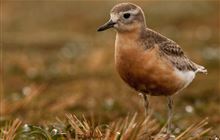Positive productivity rate for Coromandel’s dotterels
Archived content: This media release was accurate on the date of publication.
Introduction
As the breeding season for the Northern NZ dotterel/tūturiwhatu comes to a close on the Coromandel, DOC is expecting a positive productivity rate for the small and endangered shorebirds.Date: 10 March 2021
The Coromandel’s beaches are an important habitat for the dotterels, a native New Zealand species which now number more than 2500 after several years of protection efforts.
Ranger Frouk Miller is tasked with monitoring and managing the birds in DOC’s Hauraki and Coromandel districts, where 50 sites are actively monitored by DOC and volunteers.
“Because of predation and coastal property development, the dotterels are pushed out onto the beaches, out in the open, making them more vulnerable to people, dogs, avian predators such as blackback gulls and harrier hawks - and unfortunately natural elements such as storm surges coinciding with king tides,” Frouk Miller says.
“So DOC staff and volunteers are kept very busy raising and shifting nests to higher ground to keep them safe.”
DOC’s work with dotterels during the breeding season involves an extensive network of volunteers, who dedicate a significant amount of time protecting, monitoring and managing the birds. The volunteers make an important contribution to the breeding success of the species.
Frouk Miller says the signs for dotterel breeding this season are encouraging.
“I would confidently say most of our beaches, popular or isolated, have breeding pairs on them. On average and as a rule rule-of-thumb, we try to successfully fledge one chick per two nesting pairs, a productivity rate of 0.5 or higher, which means we are succeeding in increasing overall bird numbers.”
She expects about 140 chicks to fledge during this breeding season (a productivity rate of about 0.7), which commenced in late August – a little earlier than usual – and runs all the way through to mid-March.
A noticeable change this season has been the surge in visitors to the Coromandel, with the global COVID-19 pandemic ruling out international travel for New Zealanders.
Frouk Miller says the increase in visitors has brought with it the higher risk of “dog vs dotterel” incidents – with chicks becoming easy targets for dogs.
“They can’t fly for at least six weeks and they need to forage for food themselves from day one,” she says. “People are always amazed when told the adults don’t feed their chicks like other birds! They’re purely there to guard and teach them and keep them safe.”
There are six main sites – Whangamata, Pauanui/Tairua harbour, Opoutere, Matarangi, Colville and Coromandel Harbour – where the birds gather after the breeding season to feed and socialise, a seasonal activity called flocking. After flocking, the dotterels will return to their nesting sites.
Fencing and signage is erected as soon as nests are found during breeding season, to keep the birds safe from people and to create awareness the birds need to be left alone. Nests usually contain a clutch of three eggs and if predated or lost the female will lay a second or third clutch nearby. Regular weekly visits to the sites are essential and, in some cases, more frequent visits are required.
DOC having a presence on the beaches is also highly beneficial for nest and chick management and for control of dog bylaws, people disturbances and advocacy when approaching or conversing with the public.
Frouk Miller says there are positive signs the public is heeding the message to keep clear of the dotterels and help protect the birds.
“They’re taking ownership of the birds and advising people to do the right thing. It’s nice to get good feedback when on the beach and people thank us for what we are doing.”
DOC monitors and manages a number of shorebird species in the Coromandel. That work also involves engaging directly with the area’s schools, focussing on shorebird protection and educating the school children on conservation of the dotterels.
Contact
For media enquiries contact:
Email: media@doc.govt.nz

